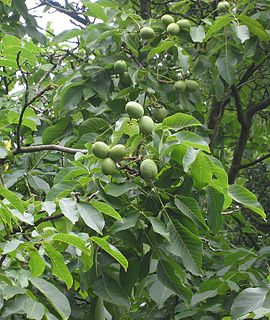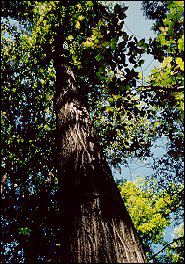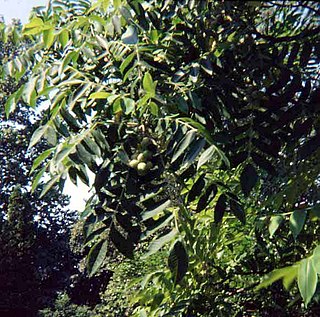
The Juglandaceae are a family, known as the walnut family, of trees, or sometimes shrubs, in the order Fagales. Various members of this family are native to the Americas, Eurasia, and Southeast Asia.
Members of the walnut family have large, aromatic leaves that are usually alternate, but opposite in Alfaroa and Oreomunnea. The leaves are pinnately compound or ternate, and usually 20–100 cm long.

Juglans cinerea, commonly known as butternut or white walnut, is a species of walnut native to the eastern United States and southeast Canada.

Juglans regia, the Persian walnut, English walnut, Circassian walnut, or especially in Great Britain, common walnut, is an Old World walnut tree species native to the region stretching from the Balkans eastward to the Himalayas and southwest China. The largest forests are in Kyrgyzstan, where trees occur in extensive, nearly pure, walnut forests at 1,000–2,000 m altitude—notably at Arslanbob in Jalal-Abad Province. It is widely cultivated across Europe.

Juglans ailantifolia, the Japanese walnut, is a species of walnut native to Japan and Sakhalin. It is a deciduous tree growing to 20 m (66 ft) tall, rarely 30 m (98 ft), and 40–80 cm stem diameter, with light grey bark. The leaves are pinnate, 50–90 cm long, with 11-17 leaflets, each leaflet 7–16 cm long and 3–5 cm broad. The whole leaf is downy-pubescent, and a somewhat brighter, yellower green than many other tree leaves. The male flowers are inconspicuous yellow-green catkins produced in spring at the same time as the new leaves appear. The female flowers have pink/ red pistils. The fruit is a nut, produced in bunches of 4-10 together; the nut is spherical, 3–5 cm long and broad, surrounded by a green husk before maturity in mid autumn.

Juglone, also called 5-hydroxy-1,4-naphthalenedione (IUPAC) is an organic compound with the molecular formula C10H6O3. In the food industry, juglone is also known as C.I. Natural Brown 7 and C.I. 75500. It is insoluble in benzene but soluble in dioxane, from which it crystallizes as yellow needles. It is an isomer of lawsone, which is the staining compound in the henna leaf.
Juglans jamaicensis, the West Indian walnut, nogal, or palo de nuez, is a species of walnut in the Juglandaceae family. It is found in Cuba, the Dominican Republic, Haiti, and Puerto Rico. It is not, in fact, native to Jamaica, as its name would suggest.

Juglans neotropica is a species of plant in the Juglandaceae family. It is found in Colombia, Ecuador, and Peru. It is threatened by habitat loss. Common names include Colombian walnut, Ecuadorian walnut, Andean walnut, nogal, cedro negro, cedro nogal, and nogal Bogotano.

Juglans mandshurica, the Manchurian walnut, is a deciduous tree of the genus Juglans, native to the Eastern Asiatic Region. It grows to about 25 m.

Juglans microcarpa, known also as the little walnut, Texas walnut, Texas black walnut or little black walnut, is a large shrub or small tree which grows wild along streams and ravines in Texas, New Mexico, Oklahoma, and Kansas. It produces nuts with a width of 1/2—3/4 in. The pinnately compound leaves bear 7—25 untoothed to finely-toothed leaflets, each 1/4—1/2 in wide. It is found at elevations ranging from 700 ft to 6700 ft.

Thousand cankers disease (TCD) is a recently recognized disease of certain walnuts. The disease results from the combined activity of the walnut twig beetle and a canker producing fungus, Geosmithia morbida. Until July 2010 the disease was only known to the western United States where over the past decade it has been involved in several large scale die-offs of walnut, particularly black walnut, Juglans nigra. However, in late July 2010 a well-established outbreak of the disease was found in the Knoxville, Tennessee area. This new finding is the first locating it within the native range of its susceptible host, black walnut.
J. californica may refer to:

A walnut is the nut of any tree of the genus Juglans, particularly the Persian or English walnut, Juglans regia.

Geosmithia morbida is a species of anamorphic fungus in the Bionectriaceae family that, together with the activity of the walnut twig beetle, causes thousand cankers disease in species of walnut trees. It was described as new to science in 2010 from specimens collected in the southern United States. The fungus, transmitted by the walnut twig beetle, Pityophthorus juglandis, is known from the western USA from California to Colorado. The cankers resulting from infection restrict nutrient flow and typically kill the host tree within three to four years. Based on closeness of internal transcribed spacer DNA, the closest relative of G. morbida is G. fassatiae. The specific epithet morbida refers to the deadly pathogenic effect it has on its host.
Pityophthorus juglandis, also known as the walnut twig beetle for feeding on several different species of walnut trees, Juglans, is one of only a few species in the genus Pityophthorus that is associated with hardwoods and the only one associated with feeding on walnut trees.















